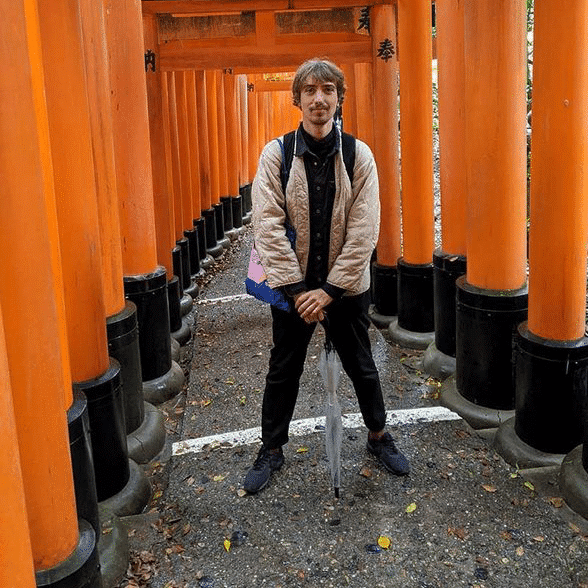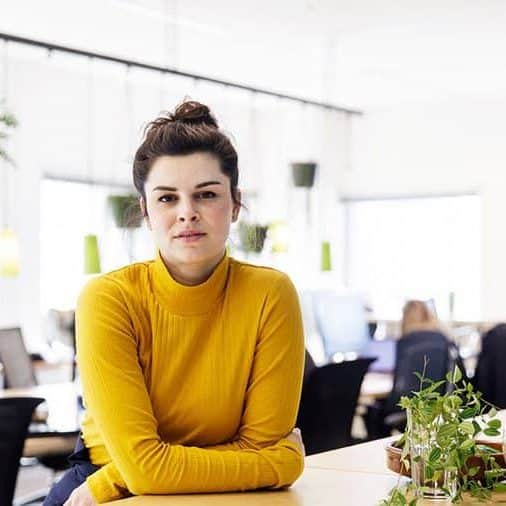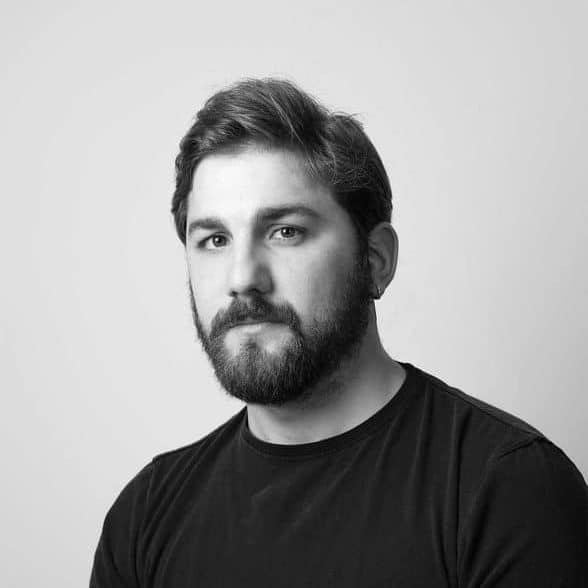Independent Universe Alumni network
The Independent Universe - the Alumni network of the Independent School for the City, includes over 300 unique thinkers, do-ers and designers who have participated in the activities of the Independent School for the city. To strengthen and expand this community of likeminded people, we regularly consult them about topics and research projects that we are doing at the school, we organise meet-ups and send out a special alumni newsletter. Below you can read the stories of some of the School's Alumni, their experiences at the school and see what they are doing at the moment.

Tanja Potezica took part in the Smooth City course with Failed Architecture in the summer of 2022 . She completed her bachelor's degree in architecture at TU Munich and currently she is pursuing her Ph.D. at the Bauhaus University. Read more about Tanja here.
Tanja Potezica completed her bachelor's degree in architecture at TU Munich before embarking on a transformative journey in the field of urbanism. It was during an exchange year at the National University of Singapore, that she fully immersed herself in the realm of urban planning and development. This experience ignited her passion, leading her to pursue a master's degree in European Urban Studies at the Bauhaus University (DE), focusing on the political and sociological dimensions of urbanism. She also undertook a research semester in Ethiopia, where she delved into the complexities of displacement of informal settlements within Addis Abeba's urban landscapes.
In the Summer of 2022, Tanja took part in the Smooth City workshop with Failed Architecture, which explored the evolving landscape of digitally driven, orderly urban spaces. Following the completion of her master's degree, Tanja worked for the Municipality of Amsterdam for five years, where she honed her expertise in power relations within urbanisation processes. Her focus on concepts such as the "Right to the City" theory led her in recent years to research the transformation of labour and work dynamics in urban contexts. She investigated questions about accessibility through labour and the balance between housing provision and employment opportunities, highlighting potential challenges in creating inclusive cities.
Currently pursuing her Ph.D. at the Bauhaus University, Tanja is deeply engaged in both research and teaching. She imparts her insights and knowledge to urbanism students, encouraging them to adopt a broader political and sociological perspective in their practice.
Her doctoral research centres on three distinct case studies: ex-Yugoslavia, Germany, and the Netherlands. Each case offers unique insights into urbanisation dynamics, with varying degrees of government influence and innovation in policymaking. From the socialist legacy of ex-Yugoslavia to the governance intricacies of Amsterdam, Tanja's work sheds light on the multifaceted nature of urban development and governance in relation to labour transformation.
Furthermore, Tanja has been critical about certain policies implemented by the City of Amsterdam, particularly concerning the current situation in the Red-Light District. These policies, she argues, have marginalised sex workers in the area, displacing their livelihoods under the guise of enhancing the city's image. In doing so, they neglect the needs of the workers who call the district home and rely on it for their livelihoods. Tanja argues that such actions exacerbate gentrification, a consequence that is evident to even the most casual observer.

Bogdan Serediak took part in the Dirty Old Town Programme in 2022, that coincided with the distressing war in his homeland. This significantly impacted his artistic journey and career trajectory. Read more about Bogdan here.
As part of Dirty Old Town, Bogdan delved into the profound subject of preserving a nation's heritage amidst the backdrop of conflict. He contemplated whether it should be conserved in its original form or reimagined through architectural interventions. Which aspects of the built environment should be safeguarded, and which should be allowed to fade away? Moreover, as the war became an indelible part of Ukraine's identity, he pondered ways to represent both the pre-war and post-war heritage.
Driven by these critical queries, Bogdan embarked on an artist residency in The Hague and Vienna after the programme's conclusion to continue his research centred around the post-war reconstruction theme. In September 2022, he relocated to Tokyo as an independent researcher at the Tama Art University with the goal to focus on innovative methods of preserving architectural landscapes. Bogdan notes that Japan's recurrent exposure to natural disasters like earthquakes and tsunamis has fostered remarkable advancements in both materialistic and contextual approaches to rebuilding practices. Currently, Bogdan is working on an exhibition in Tokyo, scheduled for July, with his proposal for post-reconstruction scenarios that utilise machine learning techniques. With this project, he hopes to foster further discussion about collective memory as well as to prioritise native design paradigms within architectural communities.

Alexandra Coutsoucos, a strategic and service designer who studied at TU Delft, participated in the Dirty Old Town programme which focuses on the urban fabric of Rotterdam from a variety of perspectives. Read more about Alexandra here.
She says that although at first glance, service design does not seem very related to urban development, she approaches the city as a network of services. “There is a lot of discussion about the city as a service. There is the hardware of the city such as the built environment and then there are the intangible relationships of services that make the city work, such as the transportation or the energy grid, or the infrastructure for the distribution of goods. For a city to become more resilient in hosting humans and non-humans in the best way possible, the role of the network of services is invaluable.”
Her office Livework studio landed a project that was about the redevelopment of an area in Bangkok, around the time she started developing an interest in the urban realm. From there they started working on the different aspects involved in the application of service design methodologies to the development of new urban realities. Alexandra remarks that, through her work in urban projects, she realised that it is a lot about community engagement, finding a communal thread between the stakeholders that make the city. It started to become the other face of all those practices that involve the citizens in the making of the city, of which tactical urbanism can be an example. “I think service design is particularly well equipped because it has a methodology and plenty of tools to create a bridge between the top-down and bottom-up perspectives. That is why the intersection of service design and urbanism is quite interesting.”
She says that the course has set her life on a new path, in the sense that she found her new niche passion, which led to Alexandra becoming the specialist in urban topics within her company. In the pursuit of consolidating her approach, she recently joined Politecnico di Milano’s design lab for social innovation called Desis Lab. Here she collaborates as a research fellow for the research project SMOTIES which builds on the Human Cities Network, while she continues working part-time in her previous job.

Bahar Orçun is an architectural designer, spatial storyteller based in Amsterdam who took part in the "Living in the Superdiverse City" Programme of 2022. She is currently the coordinator of the Independent Universe Alumni Network. Read more about Bahar here.
I am an architectural designer, spatial storyteller based in Amsterdam and I am currently the person responsible for overseeing the activities of the Alumni Network. As an expat living in the Netherlands, I understand the challenge of finding like-minded individuals and establishing meaningful connections, both personally and professionally. This is why I believe in the value of sharing our experiences with one another in the Independent Universe.
Before embarking on this journey, I had certain expectations about what it would entail and what outcomes it might yield. While some of my expectations were met, I've also learned a great deal along the way. Having the opportunity to interview fellow alumni, some of whom I knew previously and others I met for the first time during our Zoom calls, was truly eye-opening. Each person shared a unique story shaped by their experiences at the school, and it was fascinating to see how they've translated that into their own paths. A notable observation from these interviews was the multifaceted nature of our alumni—everyone seemed to wear multiple hats and possess diverse skill sets. As Anna aptly put it, "You have to be that person if you choose this path, you have to equip yourself with many talents." This, to me, epitomises the essence of our community. It is incredibly rewarding to witness what the Independent School for the City's alumni have achieved in the fields of architecture and urbanism, and I look forward to continuing this journey with all in the Independent Universe.

Anna Borunova holds a master’s degree in Art and Visual Culture from the Radboud University in Nijmegen (NL). During her studies, she interned at Crimson Historians and Urbanists, the initiators of the Independent School. Read more about Anna here.
It was during this time that Anna's professor at Radboud University recommended an internship at Crimson Historians and Urbanists, the initiators of the Independent School, providing her with an opportunity to further explore her passion for architecture and urbanism. This internship served as a catalyst for Anna, igniting her curiosity and prompting her to delve even deeper into the subject matter.
During her internship, Anna had the opportunity to contribute to ongoing research by writing a chapter titled "Gestures Towards the Socialist Landscape: The New City of Volzhsky" for the book “New Towns on the Cold War Frontier” published online by Crimson. Anna described the period of working at Crimson and the Independent School for the City as "greatly liberating." She navigated the process independently, which bolstered her self-confidence for future endeavours in the field.
Concurrently, Anna participated in the "Follow the Money" course in 2019 at the School, focusing on the housing crisis and specifically the shortage of residential units for the middle class. This workshop provided her with a comprehensive understanding of the field and elucidated the intricate relationship between economic resources and architecture.
In 2021, with the second wave of COVID-19 and for personal reasons, Anna returned to Russia. She transitioned into the role of an independent writer for the Great Russian Encyclopedia, an online portal, where she explores the works of 21st-century designers with the mindset of a researcher. This role allowed her to continue her engagement with the field while pursuing her interests in architecture and shifting them towards design.
Anna’s primary place of work now is MYRA Creative Community, a private non-governmental organisation situated in Suzdal, a city around 1000 years old. Members of the community are scattered around the world from Suzdal and Moscow to Europe, São Paulo and Jerusalem. By co-creating contemporary cultural initiatives such as art exhibitions, she actively contributes to the dialogue between the old and the contemporary, between tradition and experimentation. Within this vibrant landscape, she plays the role of collection manager. The community boasts its own art collection, focusing on books and periodicals from the avant-garde period of the 1920s and 1930s. The motto of the collection can be described in three words: beauty, eccentricity, and artistic production. Collaborating with a colleague, Anna curates the Telegram channel "Artificial Oracle," offering fortune-telling posts based on quotes from 1920s literature and sharing insights into the collection through various research topics and daily activities. Additionally, she is co-overseeing the launch of a museum shop centred around the collection. The website of the community can be visited via https://myra.ru/.

Eileen Stornbrink participated in the Earth Discovery Workshop in the spring of 2022. She studied architecture at TU Delft and has always been fascinated by the use of natural materials in architecture. Read more about Eileen here.
Together with her collaborator Danique Landburg she has acquired methods for exploring earth as a building material, to be more precise, for making rammed earth, which is a technique of pressing an earth mixture of clay, sand, stones and a bit of water in moulds until it is strong enough to be used as a wall. Eileen and Danique put the knowledge they acquired during the workshop to use by exploring the material for a design project in a small village in Para, Surinam, which is a former plantation, now owned communally by the villagers.
The region of the project in Surinam is rich with clay and sand that can be used as a building material. “Using earth as a building material has different potential depending on the location.” Eileen says. “In countries like the Netherlands, where labour is relatively expensive, rammed earth is mostly used in prestigious projects. Whereas in places where materials are relatively expensive, using earth as a building material could reduce costs. Next to adding sustainable, climatic and aesthetic value.”
She says that the material in different locations responds differently to the process of mixing and ramming, they may for example require different ratios. So, for the project in Surinam Eileen and Danique made samples of each combination, the way they learned during the Earth Discovery Workshop. Eileen remarks that using earth as a building material in this way was not very common among local builders. Therefore, these samples later became a showcase for exploring the material as resilient enough to be used in the local climate.
So far, they have tested out different mixes and built a mock-up of a wall at the site. Based on the results of the research trip, Eileen and Danique are making a design for a square and community centre named ‘Bosse Bromki Pren’ and aiming to continue building activities in 2024.

Antonio Paoletti. Architect, filmmaker and researcher Antonio Paoletti, took part in two of the school’s programmes: the Earth Discovery workshop and the Film & Architecture Studio 2022. Read more about Antonio here.
Antonio's passion for filmmaking has been a driving force throughout his journey. His academic pursuits led him to study architecture at TU Delft, where he serendipitously discovered his deep affinity for the field. Eager to forge connections between his passions, he embarked on a documentary project in Bangladesh, capturing the essence of its streets, public spaces, and inhabitants. Although he didn't initially have a specific storyline in mind, he viewed the footage as a potent tool for research and documentation.
Reflecting on the Film & Architecture Studio, Antonio acknowledges that he was primarily a self-taught filmmaker. Until then, he had predominantly used film as a means of research and documentation. The programme and especially its tutor Jord den Hollander has left a lasting impression on Antonio, significantly impacting his artistic journey, revealing the distinct nuances between making cinema and employing film as a research tool. He recalls Jord den Hollander's wise words, emphasising that "Architecture starts from concrete things, but a good movie should start from feelings."
Subsequently, Antonio received a commission to create a film centred around Skopje, exploring the city's informal inhabitation. He embarked on extensive research, delving into Macedonia's past and present, discovering the city's abundant dualities and contrasts. From its fragmented national identity to its intertwined heritage shaped by historical events, Skopje exhibited a plurality that intrigued Antonio. The city's architectural characteristics served as a means of representation, highlighting the intriguing interplay between its grand reconstruction after earthquakes and its contemporary interpretation of ancient architectural styles. Antonio keenly observed that the true contrast emerged from the everyday lives of its inhabitants. Macedonia's stark poverty, evident in the daily struggles of street vendors and small business owners juxtaposed against the grandeur of the architecture, became a story of profound dichotomies.
Antonio’s film captures the street vendors while they are reading from descriptions of ancient palace architecture and other significant structures from historical literature. This poignant juxtaposition unfolded as the hardworking vendors, their hands covered in ash and dirt, intoned the words from the books against the backdrop of modern architecture.